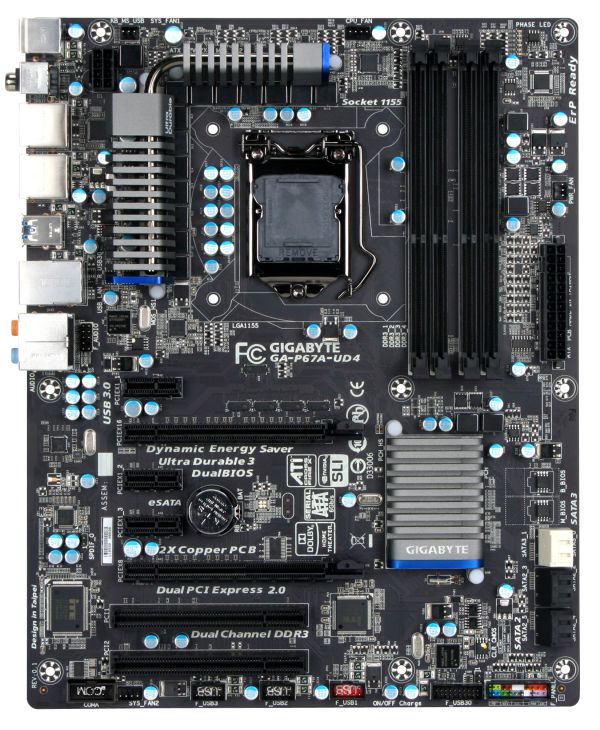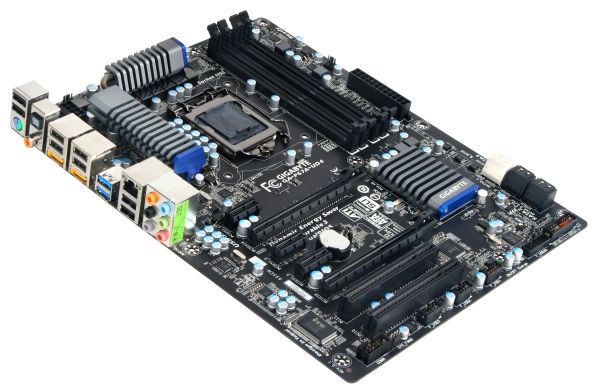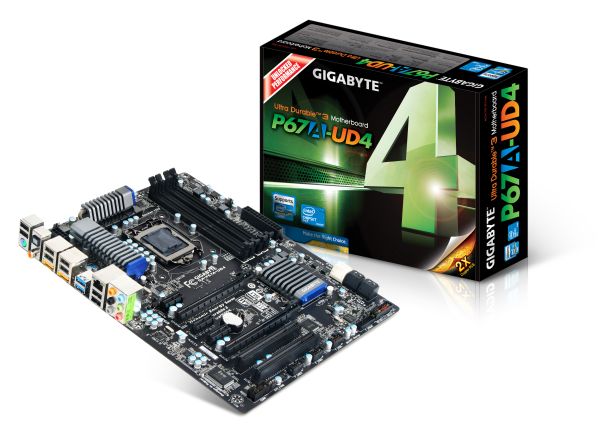The Battle of the P67 Boards - ASUS vs. Gigabyte at $190
by Ian Cutress on January 20, 2011 4:15 PM EST- Posted in
- Motherboards
- Gigabyte
- Asus
- P67
Gigabyte has five P67 motherboards up for the US Sandy Bridge release – the P67A-UD3, the P67A-UD3P, the P67A-UD4, the P67A-UD5 and the P67A-UD7. At least the naming scheme is as easy to follow as previous generations – the higher the last number, the more expensive the board and the more features on offer:
| P67A Series | |||||
| P67A-UD3 | P67A-UD3P | P67A-UD4 | P67A-UD5 | P67A-UD7 | |
| Price | $130 | $160 | $190 | $260 | $320 |
|
SATA 6 Gb/s SATA 3 Gb/s eSATA |
2 4 0 |
2 4 0 |
2 4 2 |
2 4 2 |
4 4 2 |
|
CrossFireX SLI |
Yes No |
Yes No |
Yes Yes |
Yes Yes |
Yes Yes |
|
USB 3.0 USB 2.0 |
2 12 |
4 14 |
4 14 |
8 10 |
10 8 |
| LAN | 1 | 1 | 1 | 1 | 2 |
| PCIe |
2 x16 (1 x16, 1 x4) |
2 x16 (1 x16, 1 x4) |
2 x16 (2 x8) |
3 x16 (2 x8, 1 x4) |
4 x16 (2 x16 or 4 x8) |
Visual Inspection
One of the first things I noticed about the P67A-UD4 was that it was not blue and white, like the majority of the Gigabyte motherboards have been recently that I have worked with. Predominantly featuring a black PCB, black PCIe connectors, black DIMM slots, black SATA 3Gb/s ports, a splash of white for SATA 6GB/s, silver chipset/FET coolers and a hint of old Gigabyte blue on those coolers is what we get this iteration. Not the whole range is like this – I have a H67 Gigabyte board on my desk here and that retains the blue and white credentials, as does the P67A-UD3.
The PCIe layout is slightly different to other P67 boards I have reviewed – with only two PCIe x16 slots (going to x8/x8 in dual GPU mode), there is an extra PCIe x1 slot on the board. In a dual GPU setup, this leaves two PCIe x1 and a PCI slot still free on the board, as well as a gap between dual slot GPUs to aid in cooling.
Fan headers on the board are located near the 8-pin power connector, one above the socket, one above the 24-pin power connector, and one below the PCIe slots, which would only be covered if you have a dual slot PCI card.
Gigabyte’s dual BIOS system is on this board. Yes, that is right – BIOS. No UEFI here. Well, that's not strictly true, as one of the latest BIOS updates at the time of writing (F6) implements an EFI into the BIOS, reportedly allowing bootable access to hard drives over 2.2TB. This is due to, as Gigabyte explained, that their board is actually UEFI, but without a proper GUI interface like other boards. They've used the old BIOS-style interface for now, as after years of plugging away they believe it's quick, stable and recognisable for consumers to understand. So underneath, it's truly 64-bit, meaning 2.2TB+ partition support is possible, and could also suggest that a new GUI is coming in the future. I asked about time-scale for this, but Gigabyte were undoubtedly tight-lipped about dates and implementations.
Visually, in terms of the board, there is not much else to say – the space between the socket and the PCI slots is virtually clear. There are no power, reset or clear CMOS buttons on board, neither is there a debug LED, and which is a real shame given that ASRock can do it on a $150 motherboard. Compared to the ASUS board, all the energy saving and turbo performance options are all software based – no easy flick of switches here.
Like the other P67 boards, the back panel is regular as well. Only a single PS/2 connector, 8 USB 2.0 ports, 2 USB 3.0 ports, 2 eSATA ports, S/PDIF Out connectors, a single gigabit Ethernet, and audio I/O.














137 Comments
View All Comments
Tommieemict - Wednesday, June 10, 2020 - link
nude teen sisters on periods https://teenwebcams00.uno">teenwebcams00.uno chubby indian teen nude.CarsonJoine - Wednesday, June 10, 2020 - link
naked mature selfie tits https://maturewebcams00.space">mature wife fuck tube mature fucked at massage.milf sucking teen cock https://milfwebcams00.casa">milfwebcams00.casa homies fuck white milf dp.
amateur big tit teen casting https://amateurwebcams00.xyz">amateurwebcams00.xyz amateur good looking black couple fuck.
2018 black ameature porn in hd https://blackwebcams00.icu">blackwebcams00 black amateur guy fucking amateur mexican girl.
sexy mature latina porn https://maturewebcams00.space">maturewebcams00.space thick huge tit mature pics.
JamesSag - Thursday, June 11, 2020 - link
lesbian initiation rite video https://lesbianwebcams01.fun">lesbianwebcams01.fun vintage lesbian porn gifs.moms gone black porn https://blackwebcams00.icu">pimp wife black men porn lets fuck black pussy couple porn.
gay black porn inetrracil threesomes https://blackwebcams00.icu">blackwebcams00 black nude model art.
dick an jane mature couple tumblr https://maturewebcams00.space">maturewebcams00.space gay mature tumblr masturbation.
two teens caught in pool fuck https://teenwebcams00.uno">petite teen creampie porn curvy teen girl nude strip.
Michaelsok - Friday, June 12, 2020 - link
video asian milf seduces me sex https://asianwebcams00.host">indian boss kissing and sex with receptionist fuck unconscious japanese business woman video.BrianSat - Friday, June 12, 2020 - link
sexy lesbian mom footrub https://lesbianwebcams00.fun">lesbianwebcams00.fun lesbian bondage training porn.hd milf ffm porn https://milfwebcams00.casa">hot thick milf pinterest perfect boobs milf fuck.
fucking a drunk milf https://milfwebcams00.club">milf boss fucks male employee milf monster cock creampie.
Mature blonde gang-raped on a couch https://maturewebcams00.club">maturewebcams00 young old russian mature sex.
white ass black dick https://blackwebcams00.pw">blackwebcams00.pw sexy ebony lesbian threesome.
Steveunfah - Sunday, June 14, 2020 - link
indian wife nude orgy outdoor https://asianwebcams00.host">massive asian tits tumblr asian teen fucks boyfriends friend.mary jane scott college girls nude https://collegewebcams00.store">naked college girl sex college girl rides cock gif.
chubby anal bbc amateur https://amateurwebcams00.monster">amateurwebcams00 amateur milf riding big cock creampie.
milf big ass anal https://milfwebcams00.casa">milf wants young cock gif milf next door naked.
asian fucking for a long time https://asianwebcams00.host">hot naked japanese women thai lan hd sex.
JamesSmant - Monday, June 15, 2020 - link
big hairy college cock https://collegewebcams00.store">collegewebcams00.store college girl masturbation color hidden.